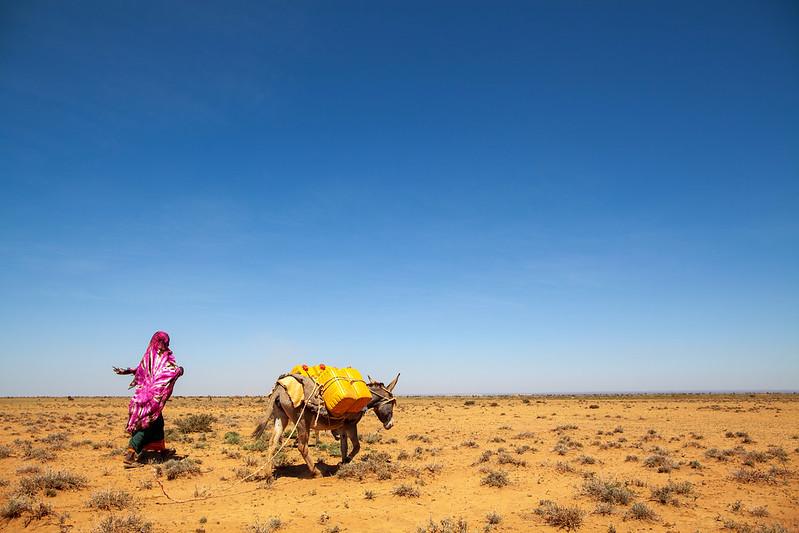Dossiers
Anticipatory action in Somalia’s water sector
Water is at the core of investment needs in Somalia. It is the essential prerequisite for a rural economy, and the main determinant for the viability of fast-growing urban centres. It is also a resource in increasingly short supply.

Collecting water at the UNDP-funded dam in Baligubadle, Somaliland, northwest Somalia
Credit Image by UNDP Somalia - CC BY-NC 2.0
Somalia is facing a water crisis on several fronts: consecutive failed rainy seasons are placing stress on a water system which is underfunded and unable to absorb such repeated or long-term shocks.
In a country with such extreme climatic, security and socio-economic fragility, Somalia’s challenge is to maintain resilient water service systems, with governance and infrastructure that is robust enough to withstand shocks, and services that can scale up to meet additional demand during crises with minimal, if any, external support.
This represents a major change from current humanitarian efforts, which focus on short-term relief interventions in response to the persistent drought and water scarcity. Water trucking is a ‘last resort’ intervention and should only be used when all options for provision/restoration of permanent water supplies have been exhausted. Permanent, reliable water supplies build resilience; water trucking does not.
However, unless investments in infrastructure development are accompanied by investment in anticipatory action – that is, helping the water sector to anticipate and respond to regular shocks – development losses will ensue.
While there are a growing number of studies and initiatives on anticipatory action, there are few in the water sector, and most are usually based on a single set of triggers, or divided according to agency mandates. They play a very limited role for crises which are long, severe, complex and unpredictable, as in Somalia’s case. The Centre for Humanitarian Change’s work in Somalia and the wider Horn of Africa suggests that government, civil society and the aid community need to strengthen resilience at a system level, to build up both risk-informed and shock-responsive water systems.
An anticipatory action plan in the water sector must consider a package of risk-informed system strengthening: identification and surveillance; well-timed interventions; and strengthening existing institutions. Each of these areas is covered in more detail below.
A combination of system strengthening and basic preparedness
Identifying problem areas in the water sector – such as water scarcity, risks related to flood water or water contamination, issues of access and affordability, or possible disease outbreaks – is a critical part of anticipatory action. This type of risk mapping and advanced planning needs to be complemented by surveillance, to track the severity and scale of a water crisis.
However, while organisations including the Food Security and Nutrition Analysis Unit Somalia (FSNAU) and Somalia Water and Land Information Management (SWALIM) provide surveillance, this data is heavily focused on food security and flood surveillance, rather than water insecurity. Recent failures to anticipate a groundwater crisis in Baidoa led to critical shortages in areas where water is most needed for internally displaced people.
A government or multi-agency water security surveillance system is needed so that action can be taken in anticipation of a crisis. Support for a government-led surveillance system is planned under the World Bank’s Somalia Crisis Recovery Project and should include specific support to the water sector. In the meantime, humanitarian donors such as USAID’s Bureau for Humanitarian Assistance have stepped in to support development of a much-needed groundwater surveillance system.
Timing is everything
Anticipatory water action also needs to consider what interventions are appropriate, where and when: a case of ‘doing the right thing, in the right place, at the right time’.
This approach requires a good understanding of the dynamics of water resources and the socio-economic situation of users in a particular area. For these reasons, such work is best implemented by local institutions, such as local authorities, NGOs, private sector water service providers and/or civil society.
This local support is all the more important, because current external support in the sector leaves a gap between those providing durable solutions to water shortage through investment in infrastructure (usually through World Bank-supported government, a UN agency or resilience consortium) and those providing emergency water supplies during a crisis (usually NGOs coordinated by The Global WASH Cluster partnership). International investors, such as the World Bank, have the potential to bridge this gap, by providing resources and technical support for existing and new water service providers to plan for a crisis and to flex and scale up their supply systems to meet demand when it occurs.
This flexibility, or ‘surge’, approach requires access to flexible financing to adapt plans and re-orientate activities in response to an anticipated crisis. The Red Cross/Red Crescent Climate Centre has developed a forecast-based financing model for drought which can provide funds to action such as stockpiling spare parts and fuel in anticipation of increased demand at strategic water points.
Bolstering institutions
The final, and possibly the most important, part of anticipatory water action is strengthening institutions that contribute to water services. This should consider the water supply system as a whole, including community management committees, private water providers and government regulatory and coordination mechanisms. The Centre for Humanitarian Change is partnering with SPARC on strengthening anticipatory action and climate security studies in Somalia which could feed into this work.
The current development response to water shortages is siloed and too focused on responding to disasters. By focusing more on system strengthening as anticipatory action in the water sector, actors can support the development of a water system that is both resilient enough to deliver reliable water supplies, and can respond to shocks.